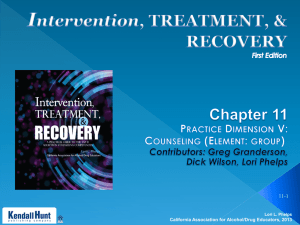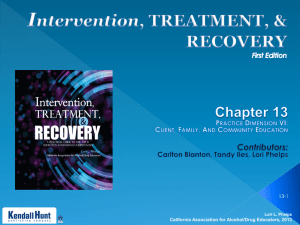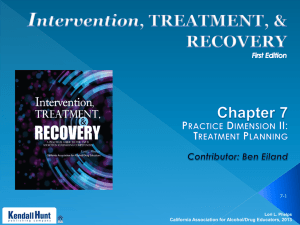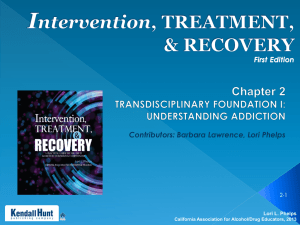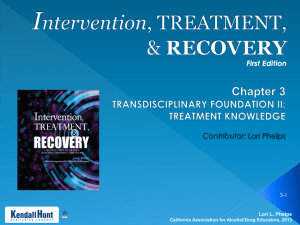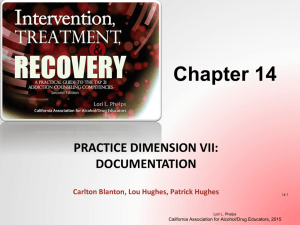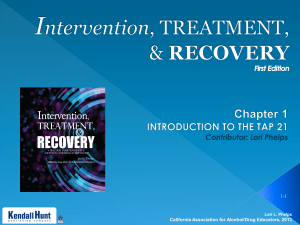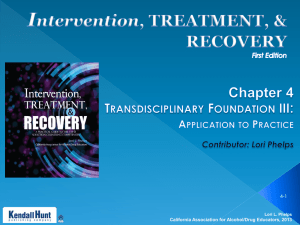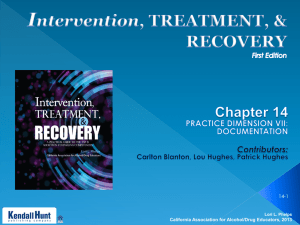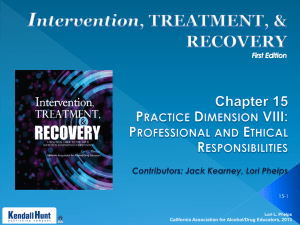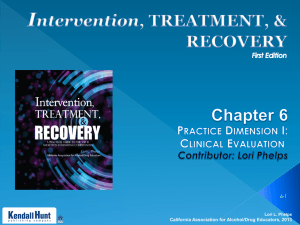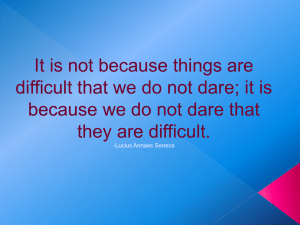Chapter 12 pptx - California Association for Alcohol/Drug Educators
advertisement
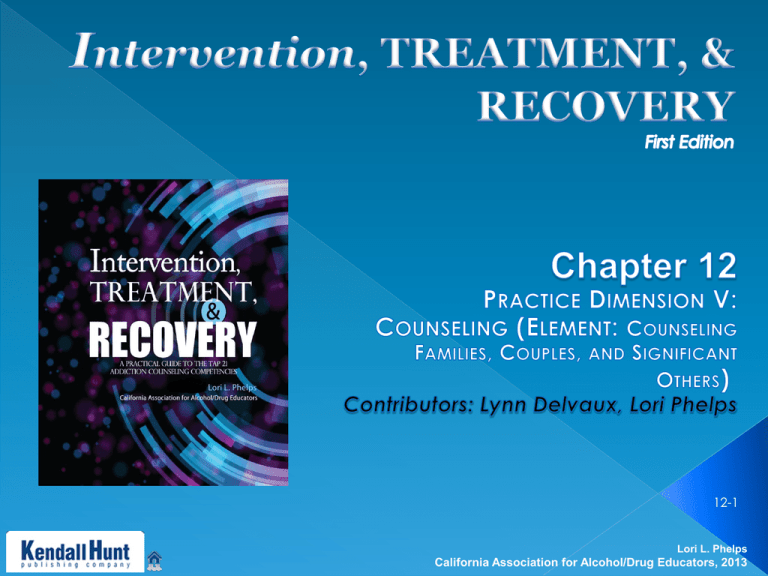
12-1 Lori L. Phelps California Association for Alcohol/Drug Educators, 2013 94: Understand the characteristics and dynamics of families, couples, and significant others affected by substance use. 95: Be familiar with and appropriately use models of diagnosis and intervention for families, couples, and significant others, including extended, kinship, or tribal family structures. 96: Facilitate the engagement of selected members of the family or significant others in the treatment and 12-2 recovery process. Lori L. Phelps California Association for Alcohol/Drug Educators, 2013 97: Assist families, couples, and significant others in understanding the interaction between the family system and substance use behaviors. 98: Assist families, couples, and significant others in adopting strategies and behaviors that sustain recovery and maintain healthy relationships. 12-3 Lori L. Phelps California Association for Alcohol/Drug Educators, 2013 Negativism Parental inconsistency Parental denial Miscarried expression of anger Self‐medication Unrealistic parental expectations 12-4 Lori L. Phelps California Association for Alcohol/Drug Educators, 2013 Johnson Intervention › a method for mobilizing, coaching, and rehearsing with family members, friends, and associates › Element of surprise Unilateral Family Therapy › applied with spouses (usually wives) of uncooperative family members who are abusing substances (typically alcohol) › “programmed confrontation” 12-5 Lori L. Phelps California Association for Alcohol/Drug Educators, 2013 Community Reinforcement Training (CRT) › Includes a number of sessions with the spouse › Attempts to take advantage of a moment when the person is motivated to get treatment by immediately calling a meeting at the clinic with the counselor, even in the middle of the night A Relational Intervention Sequence for Engagement (ARISE) › an invitational intervention method with the family conducting most of the intervention 12-6 Lori L. Phelps California Association for Alcohol/Drug Educators, 2013 Increase family support for the client’s recovery Identify and support change of family patterns that work against recovery Prepare family members for what to expect in early recovery Educate the family about relapse warning signs 12-7 Lori L. Phelps California Association for Alcohol/Drug Educators, 2013 Help family members understand the causes and effects of substance use disorders from a family perspective Take advantage of family strengths Encourage family members to obtain long-term support 12-8 Lori L. Phelps California Association for Alcohol/Drug Educators, 2013 The client is encouraged to enter treatment. The client is motivated to remain in treatment. Relapses are minimized. A supportive and healthy environment for recovery is provided. Other family members who may need treatment or other services are identified and treated. Changes in the family’s longstanding dysfunctional patterns of communication, behavior, and emotional expression may protect other family members from abusing substances. 12-9 Lori L. Phelps California Association for Alcohol/Drug Educators, 2013 Include family members in the intake session Use client-initiated engagement efforts Written invitations Incentives (refreshments, transportation, child care, etc.) Picnics or dinners for families Community reinforcement training (CRT) interventions (improve retention and outcomes) 12-10 Lori L. Phelps California Association for Alcohol/Drug Educators, 2013 Use the resources of the program › Flexible hours › Large offices › Safe toys Provide a safe, welcoming environment › A safe, clean, cheerful meeting space › well-marked and well-maintained exterior, comfortable furniture › Ice-breaking activities, simple games, and roleplay activities 12-11 Lori L. Phelps California Association for Alcohol/Drug Educators, 2013 Motivate the family Contract with the family for abstinence Al‐Anon, spousal support groups, and multifamily support groups Use the network (courts, parole officers, employer, team staff, licensing boards, child protective services, social services, lawyers, schools, etc.) Reduce anxiety 12-12 Create genograms Lori L. Phelps California Association for Alcohol/Drug Educators, 2013 Restructure family roles Realign subsystems/generational boundaries Teach relapse prevention Teach communication and conflict resolution skills Use communication skills and negotiation skills training. Employ conflict resolution techniques Use AA, Al‐Anon, Alateen, and Families 12-13 Anonymous as part of the network Lori L. Phelps California Association for Alcohol/Drug Educators, 2013 Adult Children of Alcoholics (ACOA) www.adultchildren.org Al-Anon Family Groups www.al-anon.org Families Anonymous (FA) www.familiesanonymous.org Nar-Anon Family Groups www.naranon.com National Asian Pacific American Families Against Substance Abuse www.napafasa.org 12-14 Lori L. Phelps California Association for Alcohol/Drug Educators, 2013 Matrix Intensive Outpatient Treatment for People with Stimulant Use Disorders: Counselor’s Family Education Manual w/CD http://store.samhsa.gov/product/MatrixIntensive-Outpatient-Treatment-forPeople-with-Stimulant-Use-DisordersCounselor-s-Family-Education-Manualw-CD/SMA12-4153 12-15 Lori L. Phelps California Association for Alcohol/Drug Educators, 2013 A&E Intervention http://www.aetv.com/intervention/index.jsp Moyers on Addiction: Close to Home www.pbs.org/wnet/closetohome Matrix Family Education Videos (Free CD from SAMHSA) http://store.samhsa.gov/product/MatrixFamily-Education-Videos/SMA11-4637 When Love Is Not Enough: The Lois Wilson Story › http://youtu.be/jVCYeL8Uv8s 12-16 Lori L. Phelps California Association for Alcohol/Drug Educators, 2013 12-17 Lori L. Phelps California Association for Alcohol/Drug Educators, 2013 Each participant is asked to sketch a design of their own family by describing the place where he or she was located at that table • What did my place at that table tell me about my role in that family group? For example: • Was I an active or passive participant? • How did I get attention? By rebelling, being funny, etc. • Who was my friend at that table, a parent, older or younger sibling or perhaps a grandparent? • What role did I play? A scapegoat, or my value as a person was discounted or my opinions were respected. • When I had a problem whom did I talk to? • And as I look back on that table scene do I play the same roles today? Am I a leader or a follower, am I more or less assertive, am I outgoing or pretty much into self? 12-18 Lori L. Phelps California Association for Alcohol/Drug Educators, 2013 Source: Dr. Richard Wilson 12-19 Lori L. Phelps California Association for Alcohol/Drug Educators, 2013
